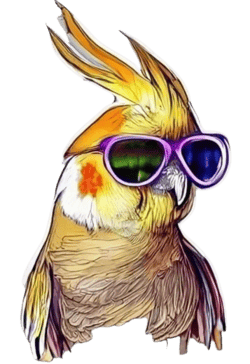Unveiling the Growth Secret: At What Age is a Cockatiel Fully Grown?
Now, let’s delve into the exciting world of cockatiels, shall we? They are like the cute universes of joy and likely to twirl your heart with their soulful chatter. Understandably, owning a cockatiel offers irreplaceable joy and companionship that many a bird lover adores. For you, a delightful ‘tiel parent, understanding their growth journey is an essential part of providing the best care for these wonderful creatures.
The Lifecycle of a Cockatiel
Cockatiels, much like the rest of us, go through different stages of life. Picture your favorite sitcom, and think of how the characters grow and change throughout the series. Cockatiels are no different (minus the sitcom drama, thankfully). So, let’s sit back and dive into the fantastic stages of their lives,
The Hatchling Stage
Think of your cockatiel Hatchling as a teeny package of fluff – helpless, eyes shut, silently screaming for attention, and some delicious cockatiel food! Cute right? But this adorable phase lasts merely around ten days.
The Fledgling Stage
Ever seen a toddler trying to walk, stumbling about, finally mastering the art? That’s how your cockatiel is at the fledgling stage. This stage, beginning after three to five weeks, is where they start to explore their wings and truly seize the day.
The Juvenile Stage
Moving on to the juvenile stage, here’s where your tile turns into a ‘teen’, all set to explore the world. It’s an action-packed period full of growth, change, and a few rebellious squawks.
Understanding these stages helps you follow their growth pattern, preparing you for the roller-coaster ride of cockatiel parentage. Each stage is essential in the overall growth of cockatiels, each packed with its own unique set of fun and challenges.
Understanding the Growth Pattern of a Cockatiel
Following your cockatiel’s growth practically requires a keen pair of eyes and a truckload of patience. Stay alert to spot the physical changes,
Changes in Feathers
The dull hatchling fluff gradually transforms into vibrant adult feathers, think of it as their version of a glow-up!
Changes in Size
Here’s an easy one, your birdie will undoubtedly grow physically bigger, just like a child shooting up during their teens.
Changes in Behavior
From shy squeaks to boisterous squawks, their personality truly takes flight as they grow.
Just like humans, not all cockatiels reach full growth at the same rate. Various factors, including nutrition, environment, genetics, and overall care play a part in how quickly they grow. It’s like piecing together a living puzzle, and you’re on the journey with them every step of the way.
When Does a Cockatiel Reach Full Growth?
So, your curious mind must be wondering, “At What Age is a Cockatiel Fully Grown?” Cockatiels typically reach their full growth between 6 to 12 months of age.
Confirming Physical Maturity
Cockatiel puberty is quite a sight to behold! They’ll get a full set of adult feathers, and their body size will pretty much stop expanding.
Confirming Behavioral Maturity
Watch out, this is the stage where your ‘tiel transitions from adorable goofiness to the ominous teenage years. You’ll notice a more structured social behavior and mating rituals may also emerge.
Assessing Sexual Maturity
Often, males start showing off their vocal talents while females display nesting behavior. They’re like teenagers discovering their identity, albeit in a birdie way.
Plenty of anecdotes and observations suggest it’s a fun and exciting time for pet parents (and sometimes a bit challenging).
Impact of Cockatiel’s Full Growth on Care Requirements
Adulthood isn’t just about dramatic physical changes; it’s also about adapting to the evolving needs of your beloved pet.
Changes in Dietary Needs
The shift from hand-feeding to a balanced diet of pellets, fruits, veggies, and seeds calls for a celebratory fiesta!
Adjustments in Housing Conditions
That tiny cage doesn’t fit well now, does it? Full-grown birds need more room to flutter around, stretch, and play.
Alterations in Social Interaction and Training
Congrats, you’ve got a functional adult bird now! Time to engage them with more complex toys, some intensive speech training, and increased social interaction.
Don’t forget about the health checks. Fully grown cockatiels might fall prey to common health issues like feather plucking or fatty liver disease. Regular vet check-ups will keep your bird happy and healthy.
Conclusion: Accompanying Your Cockatiel on Its Growth Journey
Being an integral part of your cockatiel’s growth journey is like starring in your own heartwarming movie. Rest assured, your role as an adoring pet parent contributes massively to their happy growth process.
And as they say, with great power comes great responsibility, so love your fully grown cockatiel, provide them a quality life, and be the superhero they deserve!
If you’re curious about the emotional well-being of your feathered friend and wondering whether a cockatiel can experience heart-related issues, delve into our article on “Can a Cockatiel Die From a Broken Heart?” for valuable insights into this aspect of their health and happiness.
Frequently Asked Questions
At what age do cockatiels’ feathers change color?
- Typically, a cockatiel’s feathers start changing color when they molt for the first time, roughly between 6-12 months old.
How can I tell if my cockatiel is fully grown?
- Look for physical signs like full adult plumage, and behavioral changes indicating maturity and sexual interest.
How does a cockatiel’s diet change as they grow?
- A young cockatiel typically starts by eating formula, but as they grow, their diet should be diversified to include a mix of seeds, fruits, and vegetables.
What are some common health issues in adult cockatiels?
- Some common health issues can include feather plucking, fatty liver disease, and respiratory issues.
How should my interactions with my cockatiel change as they grow?
- As your cockatiel matures, their need for social interaction and complex mental stimulation increases, so you’ll need to spend more time training and playing with your bird.
In essence, nurturing a cockatiel is like writing an epic adventure. It’s an exhilarating journey filled with love, joy, and a few feathery challenges, but at the end of the day, it’s all worth it when you see your little pal happily fluttering around, isn’t it?

About Me
I’m Kamran, a co-founder and content creator at cockatielhq.com. With 8+ years in the world of avian enthusiasts, I’ve gained extensive knowledge in caring for birds. From egg-laying and mating to cohabitation with other birds, dietary needs, nurturing, and breeding, I’m here at cockatielhq.com to share valuable insights for your avian companions.








One Comment